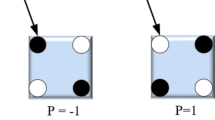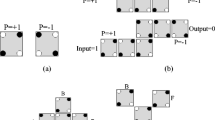Abstract
An Internet of Things (IoT) network is a graph where all nodes have the same number of links. IoT gadgets are distinct due to their limited battery capacities, short lifespans, and low sustainability. For active mode connectivity, these designs need to address a number of challenges, such as sustainable practices, effective power strategies, and quick data transmission. However, due to its widespread application in digital computer arithmetic processes, the printed device is considered one of the essential digital components of IoT circuits. To put it another way, low-power and IoT devices with longer battery life and low-power consumption may be used with the printed electronic device. As this is going on, quantum-dot cellular automata (QCA) technology is being utilized more and more to develop digital circuit systems that require less energy and are sustainable and occupied. Consequently, this study proposes a novel printed circuit with an arithmetic logic unit (ALU) structure. Implementing QCA technology emphasizes energy efficiency, sustainability, and occupied areas for miniaturizing IoT systems. Additionally, utilizing the QCADesigner-E 2.2 and QCAPro tools, all proposed frameworks are validated by simulation.











Similar content being viewed by others
Data availability
No datasets were generated or analyzed during the current study.
References
Ma Y, Li T, Zhou Y, Yu L, Jin D (2024) Mitigating Energy Consumption in Heterogeneous Mobile Networks Through Data-Driven Optimization. IEEE Transactions on Network and Service Management, 21(4):4369-4382. https://doi.org/10.1109/TNSM.2024.3416947
Yan S-R et al (2022) Implementation of a Product-Recommender System in an IoT-Based Smart Shopping Using Fuzzy Logic and Apriori Algorithm. IEEE Trans Eng Manag 71:4940–4954
Darbandi M, et al. Prediction and Estimation of Next Demands of Cloud Users based on their Comments in CRM and Previous usages. In: 2018 International Conference on Communication, Computing and Internet of Things (IC3IoT). 2018. IEEE.
Meswani MR et al (2013) Modeling and predicting performance of high performance computing applications on hardware accelerators. Int J high Perf Comput Appl 27(2):89–108
Heidari A, M.A. (2022) Jabraeil Jamali, Internet of Things intrusion detection systems: A comprehensive review and future directions. Cluster Comput 26(6):3753–3780
Li S, Xu LD, Zhao S (2015) The internet of things: a survey. Inf Syst Front 17:243–259
Seyedi S, JafariNavimipour N (2022) Designing a multi-layer full-adder using a new three-input majority gate based on quantum computing. Concurrency and Comput: Practice and Exp 34(4):e6653
Kopetz H, Steiner W (2022) Internet of things. Real-time systems: design principles for distributed embedded applications. Springer, pp 325–341
Seyedi S, Navimipour NJ (2022) An efficient structure for designing a nano-scale fault-tolerant 2: 1 multiplexer based on quantum-dot cellular automata. Optik 251:168409
Li Z, Zhang S, Mohammed BO (2023) An efficient three-level nano-design for reversible gate using quantum dot-cellular automata with cost analysis. Mater Sci Eng, B 294:116526
Salimzadeh F, Safarpoor E, Heikalabad SR (2021) Designing and implementing a fault-tolerant priority encoder in QCA nanotechnology. ECS J Solid State Sci Technol 10(6):063004
Noorallahzadeh M, Mosleh M, Ahmadpour S-S (2021) Efficient designs of reversible synchronous counters in nanoscale. Circuits Syst Signal Process 40(11):5367–5380
Zhang, X., Hou, D., Xiong, Z., Liu, Y., Wang, S., Li, Y. (2024). EALLR: Energy-Aware Low-Latency Routing Data Driven Model in Mobile Edge Computing. IEEE Transactions on Consumer Electronics. https://doi.org/10.1109/TCE.2024.3507158
Sun G, Wang Y, Yu H, Guizani M (2024) Proportional Fairness-Aware Task Scheduling in Space-Air-Ground Integrated Networks. IEEE Transactions on Services Computing, 17(6):4125-4137. https://doi.org/10.1109/TSC.2024.3478730
Navimipour NJ, Ahmadpour S-S, Yalcin S (2024) A nano-scale arithmetic and logic unit using a reversible logic and quantum-dots. J Supercomput 80(1):395–412
Gershenfeld N, Krikorian R, Cohen D (2004) The internet of things. Sci Am 291(4):76–81
Noorallahzadeh M et al (2023) A new design of parity preserving reversible Vedic multiplier targeting emerging quantum circuits. Int J Numerical Modelling: Electronic Networks, Devices and Fields. https://doi.org/10.1002/jnm.3089
Torres FS et al (2018) An energy-aware model for the logic synthesis of quantum-dot cellular automata. IEEE Trans Comput Aided Des Integr Circuits Syst 37(12):3031–3041
Afrooz S, Navimipour NJ (2021) An effective nano design of demultiplexer architecture based on coplanar quantum-dot cellular automata. IET Circuits Devices Syst 15(2):168–174
Rashidi H, Rezai A (2021) Design of novel multiplexer circuits in QCA nanocomputing. Facta Univ: Electronic Energ 34(1):105–114
Walus K et al (2004) QCADesigner: a rapid design and simulation tool for quantum-dot cellular automata. IEEE Trans Nanotechnol 3(1):26–31
Lent CS et al (1993) Quantum cellular automata. Nanotechnology 4(1):49
Lent CS, Tougaw PD (1997) A device architecture for computing with quantum dots. Proc IEEE 85(4):541–557
Tougaw PD, Lent CS (1994) Logical devices implemented using quantum cellular automata. J Appl Phys 75(3):1818–1825
Bahar AN, Wahid KA (2019) Design of QCA-serial parallel multiplier (QSPM) with energy dissipation analysis. IEEE Trans Circuits Syst II Express Briefs 67(10):1939–1943
Ahmadpour SS, Mosleh M, RasouliHeikalabad S (2019) Robust QCA full-adders using an efficient fault-tolerant five-input majority gate. Int J Circuit Theory and Appl 47(7):1037–1056
Afrooz S, Navimipour NJ (2017) Memory designing using quantum-dot cellular automata: systematic literature review, classification and current trends. J Circuits Syst Comput 26(12):1730004
Ahmadpour S-S, Mosleh M (2021) Ultra-efficient adders and even parity generators in nano scale. Comput Electr Eng 96:107548
Ahmadpour S-S et al (2022) An efficient and energy-aware design of a novel nano-scale reversible adder using a quantum-based platform. Nano Commun Networks 34:100412
Rajesh S et al (2019) A secure and efficient lightweight symmetric encryption scheme for transfer of text files between embedded IoT devices. Symmetry 11(2):293
Bali MS et al (2021) Smart architectural framework for symmetrical data offloading in IoT. Symmetry 13(10):1889
Suk J et al (2022) A stable 4-bit ALU design for printed devices. Flexible and Printed Electronics 7(1):014002
Phung TH et al (2021) IoT device fabrication using roll-to-roll printing process. Sci Rep 11(1):1–11
Sliz R et al (2020) Reliability of R2R-printed, flexible electrodes for e-clothing applications. npj Flexible Electron. https://doi.org/10.1038/s41528-020-0076-y
Heikalabad SR, Asfestani MN, Hosseinzadeh M (2017) A full adder structure without cross-wiring in quantum-dot cellular automata with energy dissipation analysis. J Supercomput 74(5):1994–2005
Ahmadpour S-S, Mosleh M (2018) A novel fault-tolerant multiplexer in quantum-dot cellular automata technology. J Supercomput 74(9):4696–4716
Abedi D, Jaberipur G, Sangsefidi M (2015) Coplanar full adder in quantum-dot cellular automata via clock-zone-based crossover. IEEE Trans Nanotechnol 14(3):497–504
Campos CAT et al (2015) Use: a universal, scalable, and efficient clocking scheme for QCA. IEEE Trans Comput Aided Des Integr Circuits Syst 35(3):513–517
Pal J et al (2022) Regular clocking based emerging technique in qca targeting low power nano circuit. Int J Electron 109(9):1550–1572
Vankamamidi V, Ottavi M, Lombardi F (2007) Two-dimensional schemes for clocking/timing of QCA circuits. IEEE Trans Comput Aided Des Integr Circuits Syst 27(1):34–44
Ahmadpour SS, Mosleh M, RasouliHeikalabad S (2019) Robust QCA full-adders using an efficient fault-tolerant five-input majority gate. Int J Circuit Theory Appl 47(7):1037–1056
Fam SR, Navimipour NJ (2019) Design of a loop-based random access memory based on the nanoscale quantum dot cellular automata. Photon Netw Commun 37(1):120–130
Sadeghi M, Navi K, Dolatshahi M, (2019) Novel efficient full adder and full subtractor designs in quantum cellular automata. J Supercomput, 1–15.
Hashemi S, Azghadi MR, Navi K (2019) Design and analysis of efficient QCA reversible adders. J Supercomput 75(4):2106–2125
Wang L, Xie G (2018) Novel designs of full adder in quantum-dot cellular automata technology. J Supercomput 74(9):4798–4816
Abutaleb M (2018) Robust and efficient QCA cell-based nanostructures of elementary reversible logic gates. J Supercomput 74(11):6258–6274
Wang Y, Xiao R, Xiao N, Wang Z, Chen L, Wen Y, Li P (2022) Wireless Multiferroic Memristor with Coupled Giant Impedance and Artificial Synapse Application. Advanced Electronic Materials, 8(10):2200370. https://doi.org/10.1002/aelm.202200370
Li H, Xia C, Wang T, Wang Z, Cui P, Li X (2024) GRASS: Learning Spatial-Temporal Properties From Chainlike Cascade Data for Microscopic Diffusion Prediction. IEEE Transactions on Neural Networks and Learning Systems, 35(11), 16313-16327. https://doi.org/10.1109/TNNLS.2023.3293689
Teodósio T, Sousa L (2007) QCA-LG: A tool for the automatic layout generation of QCA combinational circuits. in Norchip, 2007. IEEE.
Kim K, Wu K, Karri R (2007) The robust QCA adder designs using composable QCA building blocks. IEEE Trans Comput Aided Des Integr Circuits Syst 26(1):176–183
Mardiris V et al. Design and simulation of a QCA 2 to 1 multiplexer. In: 12th WSEAS International Conference on Computers, Heraklion, Greece. 2008.
Mardiris VA, Karafyllidis IG (2010) Design and simulation of modular 2n to 1 quantum-dot cellular automata (QCA) multiplexers. Int J Circuit Theory Appl 38(8):771–785
Zhang R et al (2004) A method of majority logic reduction for quantum cellular automata. IEEE Trans Nanotechnol 3(4):443–450
Cho H, Swartzlander EE (2007) Adder designs and analyses for quantum-dot cellular automata. IEEE Trans Nanotechnol 6(3):374–383
Sayedsalehi S et al (2015) Restoring and non-restoring array divider designs in quantum-dot cellular automata. Inf Sci 311:86–101
Hänninen I, Takala J (2010) Binary adders on quantum-dot cellular automata. J Signal Process Syst 58(1):87–103
Lent CS, Tougaw PD, Porod W (1994) Quantum cellular automata: the physics of computing with arrays of quantum dot molecules. In: Physics and Computation, 1994. PhysComp'94, Proceedings., Workshop on. IEEE.
Azghadi MR, Kavehie O, Navi K (2012) A novel design for quantum-dot cellular automata cells and full adders. arXiv preprint arXiv:1204.2048.
Teja VC, Polisetti S, Kasavajjala S (2008) QCA based multiplexing of 16 arithmetic & logical subsystems-a paradigm for nano computing. In: 2008 3rd IEEE International Conference on Nano/Micro Engineered and Molecular Systems. IEEE.
Gupta N, Choudhary K, Katiyal S (2013) Two bit arithmetic logic unit (ALU) in QCA. Int J Recent Trends Eng Technol 8(2):35
Sen B et al (2014) Realizing reversible computing in QCA framework resulting in efficient design of testable ALU. ACM J Emerg Technol Comput Syst (JETC) 11(3):1–22
Goswami M et al (2017) Design of testable adder in quantum-dot cellular automata with fault secure logic. Microelectron J 60:1–12
Srivastava S, Sarkar S, Bhanja S (2009) Estimation of upper bound of power dissipation in QCA circuits. IEEE Trans Nanotechnol 8(1):116–127
Timler J, Lent CS (2002) Power gain and dissipation in quantum-dot cellular automata. J Appl Phys 91(2):823–831
Sheikhfaal S et al (2015) Designing efficient QCA logical circuits with power dissipation analysis. Microelectron J 46(6):462–471
Srivastava S et al. (2011) QCAPro-an error-power estimation tool for QCA circuit design. In: Circuits and Systems (ISCAS), 2011 IEEE International Symposium on. IEEE.
Vetteth A et al. (2002) Quantum-dot cellular automata carry-look-ahead adder and barrel shifter. In: IEEE Emerging Telecommunications Technologies Conference.
Funding
No funding.
Author information
Authors and Affiliations
Contributions
The authors contributed equally in all parts of the paper.
Corresponding author
Ethics declarations
Conflict of interest
The authors declare no competing interests.
Additional information
Publisher's Note
Springer Nature remains neutral with regard to jurisdictional claims in published maps and institutional affiliations.
Rights and permissions
Springer Nature or its licensor (e.g. a society or other partner) holds exclusive rights to this article under a publishing agreement with the author(s) or other rightsholder(s); author self-archiving of the accepted manuscript version of this article is solely governed by the terms of such publishing agreement and applicable law.
About this article
Cite this article
Ya, J., Jiang, H. & Milani, F. A new design of a digital circuit for developing nanoscale IoT devices utilizing quantum-dot technology. J Supercomput 81, 572 (2025). https://doi.org/10.1007/s11227-025-07020-4
Accepted:
Published:
DOI: https://doi.org/10.1007/s11227-025-07020-4




